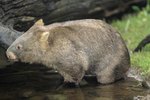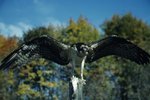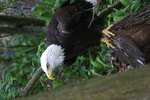
The Volga River nourishes Russia for more than 1,400 miles, from northwest of Moscow south to the Caspian Sea. More than half of the massive country's farmers rely on the "Mother Volga," and the majority of Russia's industry is situated around the waterway and its drainage. Though troubled by pollution problems, the Volga also provides habitat for numerous species.
Sturgeon
The sturgeon is the reason why Russia is associated with fine caviar, but high demand for this fish's eggs and deteriorating habitat have knocked down populations -- and hammered fishing towns -- up and down the Volga. The beluga is the largest freshwater fish in Europe, growing up to 16 feet long -- or beyond -- over its 100-plus years. Spawning grounds harmed during Soviet-era dam construction coupled with rampant poaching has led to a 90 percent drop in the Volga's sturgeon population since 1970. Government efforts to control poaching include patrols on the river.
Pelicans
One might not associate a shorebird with the chill of greater Russia. With up to a 135-inch wingspan, the rare dalmatian pelican enjoys spending March through October in the Volga River delta. Come winter, these impressive birds fly to warmer spots such as Turkey and Azerbaijan. In 2012, though, some late refugees from the Volga arrived at the Caspian Sea to find it frozen over. Officials in southern Russia stepped in to try to save the threatened birds by buying fish to feed them daily.
Flamingos
Moscow is far from sunny Florida in culture and climate, but pink flamingoes bring a bit of tropical flair to the Volga wetlands. Here is the only place in Russia where you'll find this stately, graceful bird. Flamingos stir up shallow water with their feet before plunging their bills into the water to filter out food ranging from plankton to crustaceans. It's from this diet the flamingo gets its signature pink hue, which doesn't appear until a flamingo is 2 years old.
Caspian Seal
The Caspian Sea is fed by the Volga, and sometimes the sea's iconic animal takes a trip up the Russian waterway. Caspian seals are only found in the landlocked saltwater body, and the seals are the only marine mammal there. These seals grow about 5 feet long and have gray coats. Hunters seeking the seal's blubber and the lighter coats of seal pups have slashed the population of the Caspian seal by more than 90 percent since the turn of the 20th century. It's just one of many species that find its way into the Volga River via the Caspian Sea, including at least 44 species of invertebrates and 18 species of fish.
References
- Rivers of Life: Volga
- NPR: Volga River Towns Fade Along With Prized Sturgeon
- Tennessee Aquarium: Beluga Sturgeon
- Planet of birds: Dalmatian pelican
- The Journal: Russian officials feed pelicans as ocean freezes over
- Universe Today: Europe's Longest River
- National Geographic: Greater Flamingo
- Caspian Environment Programme: Animals of the Caspian Sea
- Caspian Seal Project: Caspian seal origin, life history, threats and conservation
- Animal Diversity Web: Caspian Seal
Photo Credits
-
Harry Engels/Getty Images Sport/Getty Images




